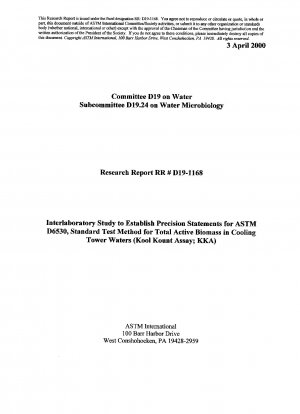ASTM RR-D19-1168 2000
D6530-Test Method for Total Active Biomass in Cooling Tower Waters (Kool Kount Assay; KKA)
- Standard No.
- ASTM RR-D19-1168 2000
- Release Date
- 1970
- Published By
- /
- Scope
- 1.1 This test method covers the determination of viable active biomass in cooling tower water in the range from 10 to 10° cfu/ml. 1.2 This test method was used successfully with reagent water, physiologic saline and cooling tower waters. It is the user's responsibility to ensure the validity of this test method for waters of untested matrices. 1.3 This standard does not purport to address all of the safety problems, if any, associated with its use. It is the responsibility of the user of this standard to establish appropriate safety and health practices and determine the applicability of regulatory limitations prior to use. For specific hazard statements, see Section 9.1.7 Precision and bias statement formats for (2) test methods yielding a non-numerical report of success or failure based on criteria specified in the procedure. 1.3.1.1 No statement is made about either the precision or the bias of Method D, Kool Kount Test Method, for measuring viable active biomass in cooling tower waters since the result merely states whether there is conformance to the criteria for success, time to development of positive color, as specified in the procedure. No difference in results for triplicate tests of each sample by the same operator was noted in the 25 sets of data generated during the Round Robin Testing of KKA. . A difference of one reading time frame (1 hour interval) was noted in two of twelve sets of data generated by different operators (2) in the same laboratory. Differences of one reading time frame (except for Laboratory #2, sample #1) were noted in eight of twenty six sets of data when all data from different operators and different laboratories for each of the four samples were compared. Five of eight samples varying from the other eighteen observations were at the lowest end of the bioconcentration detection limit by Kool Kount (i.e., 10.5 h = 10° cfu/mL; lower reliable detection limit). Comparison of KKA test results with results of the dip slide (current test method for cooling tower waters) and standard plate count methods did not show bias for higher or lower estimates of bioconcentration in the waters tested with Kool Kount.
